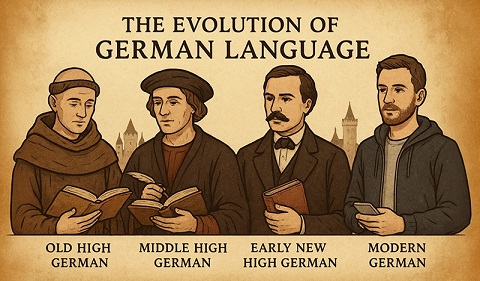
This article explores the evolution of the German language, tracing its development from its early roots to the diverse regional dialects spoken today. Along the way, we will examine how historical milestones such as Martin Luther’s Bible translation, the printing press, and German unification helped shape modern German.
The German language has evolved dramatically over the centuries, shaped by historical events, cultural shifts, and technological advancements. From Old High German to Modern Standard German, the language has gone through significant phonetic, grammatical, and lexical changes. Today, it is spoken by over 100 million people and remains one of the most influential languages in Europe.
The Origins: Old High German (500–1050 AD)
The earliest form of the German language, Old High German (OHG), emerged around 500 AD from West Germanic dialects spoken by tribes such as the Franks, Alemanni, Bavarians, and Saxons.
Key Characteristics of Old High German
- The first written German texts appear, mainly in religious and legal manuscripts.
- Strong influence from Latin, due to the spread of Christianity.
- Distinct regional dialects, as there was no standardized form of the language.
One of the most famous surviving texts from this period is the Hildebrandslied, a heroic poem that provides insight into the oral traditions of early Germanic societies.
Middle High German (1050–1350 AD): The Language of Poets and Knights
By the High Middle Ages, German had become more standardized, forming what we now call Middle High German (MHG). This was a time of linguistic refinement, as the language gained more consistent grammar and pronunciation.
Key Developments in Middle High German
- Greater phonetic clarity, making words easier to recognize compared to Old High German.
- The rise of German literature, including the famous Nibelungenlied, a medieval epic often compared to The Iliad.
- Influence from French and Latin, especially in aristocratic circles and religious texts.
This period saw the emergence of Minnesänger, or courtly poets, who wrote romantic and chivalric poetry that helped popularize Middle High German.
Early Modern German (1350–1700 AD): Printing, Luther, and Linguistic Unification
The Renaissance and Reformation played a significant role in shaping the Early Modern German language. The invention of the printing press by Johannes Gutenberg in the 15th century allowed for mass-produced books, making the German language more accessible.
Key Changes in Early Modern German
- Martin Luther’s Bible translation (1522–1534) unified German dialects and made religious texts more accessible.
- The decline of Latin, as German became the primary language for education and governance.
- Standardization of spelling and grammar, thanks to the wide circulation of printed texts.
Luther’s translation of the Bible had a profound effect on German speakers, creating a more uniform written language that laid the groundwork for Modern Standard German.
The Development of Standard German (1700–1900 AD)
By the 18th and 19th centuries, efforts to create a single, standardized German language intensified. The goal was to unify the many regional dialects spoken across German-speaking territories.
Key Aspects of Standard German Development
- The rise of dictionaries and grammar guides, which formalized spelling and pronunciation.
- The literary influence of Johann Wolfgang von Goethe and Friedrich Schiller, who set a new standard for written German.
- The political unification of Germany in 1871, which reinforced the need for a national language.
By the late 19th century, Hochdeutsch (High German) became the dominant form of Standard German, used in government, education, and media.
Modern German and Regional Dialects (1900–Present)
Today, Standard German (Hochdeutsch) is the official language of Germany, Austria, and Switzerland, but it coexists with regional dialects that add linguistic diversity.
Major German Dialect Groups
- High German (Hochdeutsch) – Spoken in central and southern Germany, Austria, and Switzerland. Includes Bavarian, Swabian, and Franconian dialects.
- Low German (Plattdeutsch) – Spoken in northern Germany, with influences from Dutch and Scandinavian languages.
- Middle German (Mitteldeutsch) – Includes dialects such as Thuringian, Hessian, and Saxon, forming a bridge between High and Low German.
The Influence of Globalization on Modern German
- The rise of English loanwords, particularly in technology, business, and pop culture.
- The decline of dialect use among younger generations, as Standard German dominates digital communication and media.
- The impact of immigration, introducing new vocabulary and linguistic influences into modern German.
Practical Applications and Everyday Influence
The history of the German language is not just an academic topic – it has real-world implications. Here are a few examples:
- German dialects still influence everyday speech, with strong regional variations in pronunciation and vocabulary.
- Historical texts and documents require knowledge of older German forms, making linguistic history essential for historians and translators.
- Many German idioms and expressions have medieval origins, reflecting the deep connection between culture and language.
The evolution of the German language is a testament to its resilience and adaptability. From its early beginnings in Old High German to its current status as a global language, German has continuously transformed while maintaining its rich linguistic heritage.
While Standard German serves as the unifying force for communication, regional dialects keep the language dynamic and diverse. As globalization and technology continue to shape language use, German will undoubtedly continue evolving, blending its historical roots with the needs of modern speakers.
For more insights into German history, dialects, and linguistic traditions, explore our articles on The Amusing German Language, The Role of Martin Luther in Shaping German, and German Dialects and Their Cultural Significance.
Related:
Bavarian vs. Prussian: Regional Rivalries and Cultural Identity
